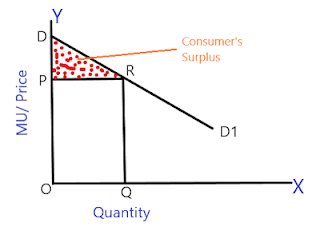Consumer’s surplus
The law of consumer’s surplus was first developed by French engineer A.J. Dupuit in 1844 A.D, to measure the social benefits of public commodities such as canals, bridges, national highways, etc. This concept was further refined and popularized by Alfred Marshall.According to Marshall,” Excess of the price which a consumer will be willing to pay rather than go without a thing over that which he/she actually does pay is the economic measure of this surplus satisfaction. It may be called the consumer’s surplus.”
The amount of money which a person is prepared to pay for a commodity indicates the amount of utility that he/she derives from that commodity. Greater the amount of money he/she is willing to pay, greater the satisfaction he/she will receive.
Consumer’s surplus equals to what a consumer is prepared to pay minus what he/she actually pays.
Symbolically,
CS = TU - TE
Where;
TU= Total Utility
TE=Total expenditure
Assumptions of Consumer’s surplus
- The consumer should be rational.
- Utilities are measured in cardinal number.
- MU of money remains constant.
- The expected price should be more than the actual price.
- All units of the commodity should be homogeneous.
- Price of the commodity should remain constant.
Units | Willingness to pay (MU) | Paid amount | Consumer's surplus |
1 | 100 | 25 | 75 |
2 | 75 | 25 | 50 |
3 | 50 | 25 | 25 |
4 | 25 | 25 | 0 |
TU= 250 | TE= 100 | CS= 150 |
In the above schedule, Units of commodity, marginal utility (MU) of each commodity, the actual price of each commodity and consumers surplus is shown. The marginal utility declines after consumption of each additional unit. The price of the commodity remains constant. Actual price is subtracted from marginal utility to get consumers surplus. The total utility obtained is 250 with a total paid 100. The overall consumer’s surplus is 150. It can be also presented in the following diagram.
In the above figure, quantity is measured along x-axis and price or MU is measured along y-axis. DD1 is the MU curve for the commodity. At OP price, OQ units of a commodity are purchased and the price paid is OP × PQ. This is equal to the area OPRQ. But the total amount of money he is prepared to pay is OD for OQ quantity. This is equal to the area ODRQ. The consumer's surplus, therefore it is equal to ODRQ -OPRQ is equal to PDR.
Criticisms of consumer's surplus
- Imaginary
- The utility is not measurable
- MU of money never remains constant
- Not applicable to necessaries
- Neglects complementary commodities
- Neglects substitutes
Importance of consumer’s surplus
- In public finance
- To the business person and monopolist
- Comparing the advantages of different places
- Measuring benefits from international trade
- The distinction between value in use and value in exchange


0 Comments
If this article has helped you, please leave a comment.